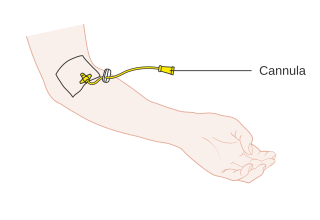Related Research Articles

Plastic surgery is a surgical specialty involving the restoration, reconstruction, or alteration of the human body. It can be divided into two main categories: reconstructive surgery and cosmetic surgery. Reconstructive surgery includes craniofacial surgery, hand surgery, microsurgery, and the treatment of burns. While reconstructive surgery aims to reconstruct a part of the body or improve its functioning, cosmetic surgery aims to improve the appearance of it. A comprehensive definition of plastic surgery has never been established, because it has no distinct anatomical object and thus overlaps with practically all other surgical specialties. An essential feature of plastic surgery is that it involves the treatment of conditions that require or may require tissue relocation skills.

A cannula is a tube that can be inserted into the body, often for the delivery or removal of fluid or for the gathering of samples. In simple terms, a cannula can surround the inner or outer surfaces of a trocar needle thus extending the effective needle length by at least half the length of the original needle. Its size mainly ranges from 14 to 26 gauge. Different-sized cannula have different colours as coded.
A wrinkle, also known as a rhytid, is a fold, ridge or crease in an otherwise smooth surface, such as on skin or fabric. Skin wrinkles typically appear as a result of ageing processes such as glycation, habitual sleeping positions, loss of body mass, sun damage, or temporarily, as the result of prolonged immersion in water. Age wrinkling in the skin is promoted by habitual facial expressions, aging, sun damage, smoking, poor hydration, and various other factors. In humans, it can also be prevented to some degree by avoiding excessive solar exposure and through diet.

Hyaluronic acid, also called hyaluronan, is an anionic, nonsulfated glycosaminoglycan distributed widely throughout connective, epithelial, and neural tissues. It is unique among glycosaminoglycans as it is non-sulfated, forms in the plasma membrane instead of the Golgi apparatus, and can be very large: human synovial HA averages about 7 million Da per molecule, or about 20,000 disaccharide monomers, while other sources mention 3–4 million Da.
Chin augmentation using surgical implants alter the underlying structure of the face, intended to balance the facial features. The specific medical terms mentoplasty and genioplasty are used to refer to the reduction and addition of material to a patient's chin. This can take the form of chin height reduction or chin rounding by osteotomy, or chin augmentation using implants. Altering the facial balance is commonly performed by modifying the chin using an implant inserted through the mouth. The intent is to provide a suitable projection of the chin as well as the correct height of the chin which is in balance with the other facial features.
Polyalkylimide is a polymer whose structure contains no free monomers. It is used in permanent dermal fillers to treat soft tissue deficits such as facial lipoatrophy, gluteal atrophy, acne, and scars.
Lip augmentation is a cosmetic procedure that modifies the shape of the lips using fillers, such as collagen or implants. The procedure may be performed to increase lip size, correct asymmetry, create protrusion, or adjust the ratio of the top and bottom lips. The procedure typically involves surgical injection, though temporary non-surgical alternatives exist.
Facial rejuvenation is a cosmetic treatment, which aims to restore a youthful appearance to the human face. Facial rejuvenation can be achieved through either surgical and/or non-surgical options. Procedures can vary in invasiveness and depth of treatment. Surgical procedures can restore facial symmetry through targeted procedures and facial restructuring and skin alterations. Non-surgical procedures can target specific depths of facial structures and treat localized facial concerns such as wrinkles, skin laxity, hyperpigmentation and scars.
Sculptra is a proprietary formulation of poly-L-lactic acid (PLLA) that is an FDA-approved dermal filler manufactured by Dermik Laboratories, which conducts the American business of Aventis Dermatology, the global dermatology unit of Aventis.
Restylane is the trade name for a range of injectable fillers with a specific formulation of non-animal sourced hyaluronic acid (HA).
Aquamid is a non-absorbable soft volume filler for aesthetic and reconstructive purposes. Aquamid is the trade name for a specific formulation of 97.5% water for injection and 2.5% cross-linked polyacrylamide. It is injected subcutaneously to correct wrinkles and folds or to add volume. Common aesthetic indications are nasolabial folds, lip augmentation, cheek contouring, nose enhancement. Aquamid is also used to correct signs of facial lipoatrophy or fat wasting in HIV+ patients.
Artefill is a permanent injectable wrinkle filler, for the correction of smile lines. Artefill was approved by the U.S. Food and Drug Administration (FDA) as a medical device in October 2006. A prior version of the product called Artecoll has been marketed in Canada and Europe since the 1990s.

Sodium hyaluronate is the sodium salt of hyaluronic acid, a glycosaminoglycan found in various connective tissue of humans.

Photoaging or photoageing is a term used for the characteristic changes to skin induced by chronic UVA and UVB exposure. Tretinoin is the best studied retinoid in the treatment of photoaging.
Silicone granulomas are a skin condition that occur as a reaction to liquid silicones, and are characterized by the formation of nodules.
Aesthetic medicine is a branch of modern medicine that focuses on altering cosmetic appearance through the treatment of conditions including scars, skin laxity, wrinkles, moles, liver spots, excess fat, cellulite, unwanted hair, skin discoloration, and spider veins. Traditionally, it includes dermatology, oral and maxillofacial surgery, reconstructive surgery and plastic surgery, surgical procedures, non-surgical procedures, and a combination of both. Aesthetic medicine procedures are usually elective. There is a long history of aesthetic medicine procedures, dating back to many notable cases in the 19th century, though techniques have developed much since then.

Mitchel P. Goldman, is an American dermatologic surgeon, cosmetic surgeon, dermatologist, and phlebologist, and the founder and director of Cosmetic Laser Dermatology. He is also a past president of the American Society for Dermatologic Surgery, the American College of Phlebology, the San Diego County Dermatology Society, and the Sonoran Dermatology Society.
Non-surgical rhinoplasty is a medical aesthetic procedure in which injectable fillers, most commonly hyaluronic acid ones like Restylane and Juvederm or calcium hydroxyapatite (Radiesse), are used to alter and shape a person's nose without a surgery. The procedure fills in depressed areas on the nose, lifting the angle of the tip or smoothing the appearance of bumps on the bridge. Non surgical rhinoplasty is an augmentation procedure, so it cannot reduce the size of someone's nose. The cosmetic procedure carries the risk of causing serious skin damage or distant complications like blindness. If the filler product is injected into an artery, filler can travel in the arteries and blocks smaller size arteries like ophthalmic artery and cause blindness. If blood vessels of the skin is blocked, skin necrosis can develop. Hyaluronic acid based fillers can be reversed even if injected into a blood vessel with an enzyme called hyaluronidase, which can be also injected like fillers.
Radio-frequency skin tightening is an aesthetic technique that uses radio frequency (RF) energy to heat skin with the purpose of stimulating cutaneous collagen, elastin and hyaluronic acid production in order to reduce the appearance of fine lines and loose skin. The technique induces tissue remodeling and production of new collagen and elastin. The process provides an alternative to facelift and other cosmetic surgeries.
Fat transfer, also known as fat graft, lipomodelling, or fat injections, is a surgical process in which a person's own fat is transferred from one area of the body to another area. The major aim of this procedure is to improve or augment the area that has irregularities and grooves. Carried out under either general anesthesia or local anesthesia, the technique involves 3 main stages: fat harvesting, fat processing, fat injection.
References
- ↑ Gold MH (2007). "Use of hyaluronic acid fillers for the treatment of the aging face". Clin Interv Aging. 2 (3): 369–76. doi: 10.2147/cia.s1244 . PMC 2685277 . PMID 18044187.
- ↑ Bray, Dominic; Hopkins, Claire; Roberts, David N. (2010). "A review of dermal fillers in facial plastic surgery". Current Opinion in Otolaryngology & Head and Neck Surgery. 18 (4): 295–302. doi:10.1097/MOO.0b013e32833b5162. ISSN 1531-6998. PMID 20543696. S2CID 205831647.
- ↑ Liu, Michael H.; Beynet, David P.; Gharavi, Nima M. (June 2019). "Overview of Deep Dermal Fillers". Facial Plastic Surgery. 35 (3): 224–229. doi:10.1055/s-0039-1688843. ISSN 0736-6825. PMID 31189194. S2CID 189816072.
- ↑ Lorenc, Z. Paul; Bruce, Suzanne; Werschler, William Philip (July 2013). "Safety and efficacy of a continuous-flow, injection-assisted device in delivery of dermal fillers". Aesthetic Surgery Journal. 33 (5): 705–712. doi: 10.1177/1090820X13487372 . ISSN 1527-330X. PMID 23671210.
- ↑ Gooderham, Melinda; Solish, Nowell (2006-03-21). "Use of Hyaluronic Acid for Soft Tissue Augmentation of HIV-Associated Facial Lipodystrophy". Dermatologic Surgery. 31 (1): 104–108. doi:10.1111/j.1524-4725.2005.31020. ISSN 1076-0512. PMID 15720106. S2CID 22820504.
- ↑ Moyle, GJ; Lysakova, L.; Brown, S.; Sibtain, N.; Healy, J.; Priest, C.; Mandalia, S.; Barton, SE (2004). "A randomized open-label study of immediate versus delayed polylactic acid injections for the cosmetic management of facial lipoatrophy in persons with HIV infection". HIV Medicine. 5 (2): 82–87. doi: 10.1111/j.1468-1293.2004.00190.x . PMID 15012646.
- ↑ Jagdeo, Jared; Ho, Derek; Lo, Alex; Carruthers, Alastair (2015-12-01). "A systematic review of filler agents for aesthetic treatment of HIV facial lipoatrophy (FLA)". Journal of the American Academy of Dermatology. 73 (6): 1040–1054.e14. doi: 10.1016/j.jaad.2015.08.040 . ISSN 0190-9622. PMID 26481056.
- ↑ Sturm, Lana P.; Cooter, Rodney D.; Mutimer, Keith L.; Graham, John C.; Maddern, Guy J. (September 2009). "A systematic review of permanent and semipermanent dermal fillers for HIV-associated facial lipoatrophy". AIDS Patient Care and STDs. 23 (9): 699–714. doi:10.1089/apc.2008.0230. ISSN 1557-7449. PMID 19673594.
- ↑ Sturm, Lana P.; Cooter, Rodney D.; Mutimer, Keith L.; Graham, John C.; Maddern, Guy J. (September 2009). "A Systematic Review of Permanent and Semipermanent Dermal Fillers for HIV-Associated Facial Lipoatrophy". AIDS Patient Care and STDs. 23 (9): 699–714. doi:10.1089/apc.2008.0230. ISSN 1087-2914. PMID 19673594.
- ↑ "Consumer Updates - Filling in Wrinkles Safely". Food and Drug Administration .
- ↑ Health, Center for Devices and Radiological. "Dermal Fillers" (WebContent). Food and Drug Administration . Retrieved 2015-03-07.
- ↑ Stadelman-Behar, Anna M. (2024). "Investigation of Presumptive HIV Transmission Associated with Receipt of Platelet-Rich Plasma Microneedling Facials at a Spa Among Former Spa Clients — New Mexico, 2018–2023". MMWR. Morbidity and Mortality Weekly Report. doi:10.15585/mmwr.mm7316a3 . Retrieved 2024-04-25.
- ↑ Ferneini, EM; Ferneini, AM (August 2016). "An Overview of Vascular Adverse Events Associated With Facial Soft Tissue Fillers: Recognition, Prevention, and Treatment". Journal of Oral and Maxillofacial Surgery. 74 (8): 1630–6. doi:10.1016/j.joms.2016.03.009. PMID 27067061.
- ↑ Souza Felix Bravo, B; Klotz De Almeida Balassiano, L; Roos Mariano Da Rocha, C; Barbosa De Sousa Padilha, C; Martinezt Torrado, C; Teixeira Da Silva, R; Carlos Regazzi Avelleira, J (December 2015). "Delayed-type Necrosis after Soft-tissue Augmentation with Hyaluronic Acid". The Journal of Clinical and Aesthetic Dermatology. 8 (12): 42–7. PMC 4689510 . PMID 26705447.
- ↑ Beleznay, K; Carruthers, JD; Humphrey, S; Jones, D (October 2015). "Avoiding and Treating Blindness From Fillers: A Review of the World Literature". Dermatologic Surgery. 41 (10): 1097–117. doi:10.1097/dss.0000000000000486. PMID 26356847. S2CID 205583192.
- ↑ "Dermal Fillers (Soft Tissue Fillers)". www.fda.gov. Center for Devices and Radiological Health. Archived from the original on 2018-09-08. Retrieved 2018-03-14.
- ↑ Bray, Dominic; Hopkins, Claire; Roberts, David N. (2010). "A review of dermal fillers in facial plastic surgery". Current Opinion in Otolaryngology & Head and Neck Surgery. 18 (4): 295–302. doi:10.1097/MOO.0b013e32833b5162. ISSN 1531-6998. PMID 20543696. S2CID 205831647.
- ↑ "The Overview of Requirement for High Risk Cosmetic Devices in Different Countries". 2019.